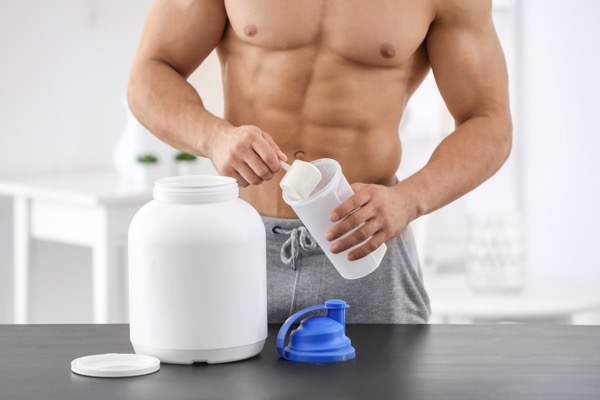Choosing a Whey Protein Powder
We all know that consuming sufficient protein helps to build and maintain muscle mass. When we exercise this will itself signal the muscle to repair and grow and certain amino acids like leucine are particularly important for muscle growth and recovery.
While food is the best way to get your protein needs, it is not always practicable and if you are excluding certain foods from your diet it may be harder to reach your daily requirements. This is why protein powders are one of the most popular supplements particularly when it comes to exercise.
Hit any health shop and it is easy to feel overwhelmed by the protein powders on display and top of list is whey.

What is Whey?
Whey protein is one of the two types of protein made from dairy, the other being casein. During cheese making the curds (solid part which are used to make casein protein) are separated from the whey ( the liquid portion of the milk). Roughly speaking there is about 4 times as much casein as there is whey in milk. The whey is then filtered and dried to form a powder.
Whey and casein are both considered high-quality proteins because they contain all the amino acids needed by your body. However, whey is considered particularly beneficial for increasing the production of new protein in your muscles.
Whey is one of the most popular sources and for good reason. It is easily digested, quickly absorbed and a good source of leucine and the other branched chain amino acids. It is also a good source of glutamine – another important amino acid when it comes to muscle mass.
Whey also contains a number of other beneficial nutrients including lactoferrin, beta-lactoglobulin, alpha-lactalbumin and immunoglobulins. These additional nutrients have been shown to be beneficial for our health including lowering blood pressure, blood sugar, lower inflammation and supporting immune function. Whey has also been shown to be useful for detoxification and may have anti-cancer properties.
This may be due to its high level of cysteine which in turn raises levels of glutathione, the main antioxidant substance in your body’s cells. Whey also appears to reduce appetite making it ideal for weight loss.

Different forms of Whey
The most common forms are whey isolate, whey concentrate and hydrolysate. They have slightly different nutritional profiles due to the processing methods but they have very similar fitness and health benefits.
Generally speaking due to higher amount of processing used to produce whey isolate compared to concentrate a whey isolate will have a higher protein content with less fat and carbohydrate content per serving.
Whey isolate also has lower lactose content which can be useful for those who are lactose intolerant. However it is worth noting that the levels even in concentrate are still low per serving and so still likely to be tolerated.
Due to the processing steps whey isolate is often more expensive than concentrate. Whey concentrate typically retains more of the beneficial nutrients found naturally in whey and often tastes better due to the slightly higher fat content.
Concentrate: About 70–80% protein; contains some lactase (milk sugar) and fat – often creamier in taste
Isolate: around 90% protein; contains less lactose and fat but lacks a lot of the beneficial nutrients found in whey protein concentrate.
What about Hydrolysate?
Also known as hydrolysed whey, this type has been pre-digested so that it gets absorbed faster. It can cause a 28–43% greater spike in insulin levels than isolate. Often due to the processing it is less allergenic.
As it appears to be digested faster it may be a better choice if you are using whey before exercise but is unlikely to give you any better gains that other forms of whey if using it post workout or through the day to increase overall protein intake. It is generally more expensive and often has a slightly bitter taste (unless loaded with additives!) so for the extra cost may not be worth it. The main reason you may wish to choose this option is if you use a protein shake during a workout or you find the other forms are difficult on the stomach.
Some products will say partially hydrolysed whey isolate – which really means that some of the product is hydrolysed and some is not – the difficulty with these products is that often they do not specify how much of each. The actual amount of hydrolysed protein may only be 1%.
What About Processing?
All whey has to be filtered and dried but you will find various companies stating the various technique they use.
Microfiltration and ultrafiltration refer to types of processing that focus on the size of the molecule in particular. These techniques are sometimes employed to increase the content of some of the bioactive peptides such as alpha-lactalbumin which may have their own specific health benefits. The trouble is that just because a company states they are using these processing techniques it does not mean it actually results in a higher concentration of these bioactive peptides unless they are measured and stated on the tub. Yet they are likely to charge more.
Cold Pressed. This refers to High Pressure Processing (HPP) which means the processing uses pressure rather than heat. This can improve the taste but other than that there is little research to suggest it has any specific health benefits.

What’s the Best Whey Protein?
So with all these difference what makes the best whey protein powder?
If you are concerned about lactose levels or really want something ultra-low fat then an isolate may be a better option. But you may wish to start with a concentrate first to see if these are tolerated – they are generally cheaper, taste better and typically contain more of the additional peptides.
For me here are some key considerations:
- Price – If you are going to consume protein powder daily or on a regular basis it has to be affordable. Watch out for marketing hype of certain brands which charge more without providing additional health benefits.
- Taste – if you end up having to add loads of fruit, flavoured liquids etc just to make it palatable forget it!
- Quality – what is the source of the protein? For me it has to be sourced from organic / grass fed cows. I want transparency from a brand – it should be able to state exactly where it is sourced.
- Additives – many cheaper brands pile in loads of sugars or sweeteners or artificial flavours to make it more palatable. Ditch these.

